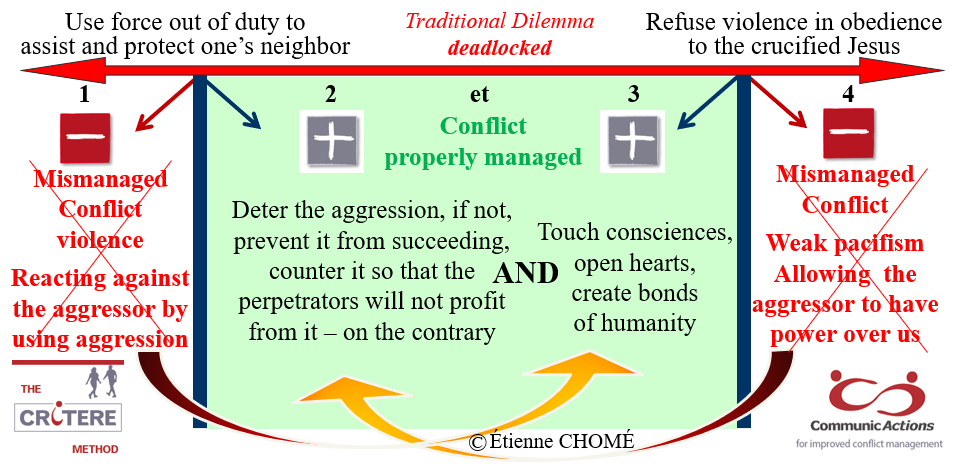By understanding that turning the other cheek (Mt 5:38-42) is a call to not resist, to renounce one’s own rights, to bear injustice patiently, the coryphaei of Tradition were obliged to limit evangelical non-violence as best they could:
1) Yes, to the evangelical spirit while still assuring an effective defense, was the idea of Augustine. As the Church became the official religion of the Empire, he organized an internalizing solution that distinguished actions from intentions: the commandments of Mt 5:38-42, which are addressed to everyone, do not teach a specific behavior, but a « spirit » in which we should defend ourselves. The texts do not say: « Let the wicked do as they wish, » but rather, « Correct the wicked, while loving them entirely with your heart filled with pure intention ».
2) Yes, to turning the other cheek, but not for everyone, was the proclamation of Thomas Aquinas reflecting the spirit of his time. In the medieval era, which clearly marked the differences between clerics and laity, Mt 5:38-42 was applied differently to each: one commandment for those who had left everything behind in order to witness in anticipation of the Kingdom, and on the other hand, for all those who had the responsibility of protecting their family, their business or their country, a counsel of perfection subordinated to the duty of defending one’s neighbor. Religious can bear witness to that radical love which goes so far as to give one’s life for one’s enemy, while the laity exercise their vocation of love by defending their loved ones. This is the solution of a free and personal vocation.
3) Yes, to this impossible precept, but by grace, and only for Christians in their interpersonal relationships, affirms Luther. The Protestant Reformation centers on the Savior who alone is able to give the grace to accomplish what he asks in Mt 5:38-42. This is the Christological solution. Mt 5:38-42, sets out commandments for every Christian, whether cleric or layman. But they are valid only in the relationship of Christian to Christian; honoring the Kingdom of God which comes in Christ. They are not valid, as such, for governors, judges or economic leaders in the organization of the affairs of the society.
These three theologies, which express the ideal of the society in which they were produced, agree on the following guidelines: yes as much as possible to the evangelical precepts of non-violence in Mt 5:38-42, but it is necessary to limit those to whom it is addressed, and/or the obligatory character and/or the scope of its application, given the need to protect the innocent against violence and to resist injustice. Hence the dilemma that has arisen in all Christian thought over the last two thousand years between the duty to assist and protect one’s neighbor on the one hand, and on the other, to remain faithful to the non-violence advocated by Jesus in his words and actions. Ambrose of Milan already spoke in the fourth century of this conflict of duties for every Christian, which is taken up again by the Jesuit Joseph Joblin: one will either observe the precept that he must abstain from all violence, and fail in his obligation to come to the aid of the victim of unjust aggression (because of the risk of becoming an accomplice of the unjust aggressor); or, he will put his strength at the disposal of the victim of injustice and he will fail in the precept of non-violence contained in the gospel
Today, studies in conflict management reveal that this dilemma is very poorly framed. See the diagram below: departing from the traditional dilemma because the best possible defense is neither in counter-aggression nor in passivity, it is rather in a mobilization of our best forces and an optimization of those ingredients that there will be an effective resolution to the crisis. And, on the Gospel side, if we understand that the outstretched cheek is a call to resist, to fight against injustice by taking a disconcerting initiative which does not fall into the trap of counter-violence, but which effectively stops the dominance, then a theology of a just peace becomes possible, integrating both the treasures of the Gospel and the know-how of constructive conflict management. See my book « La non-violence évangélique et le défi de la sortie de la violence ».
